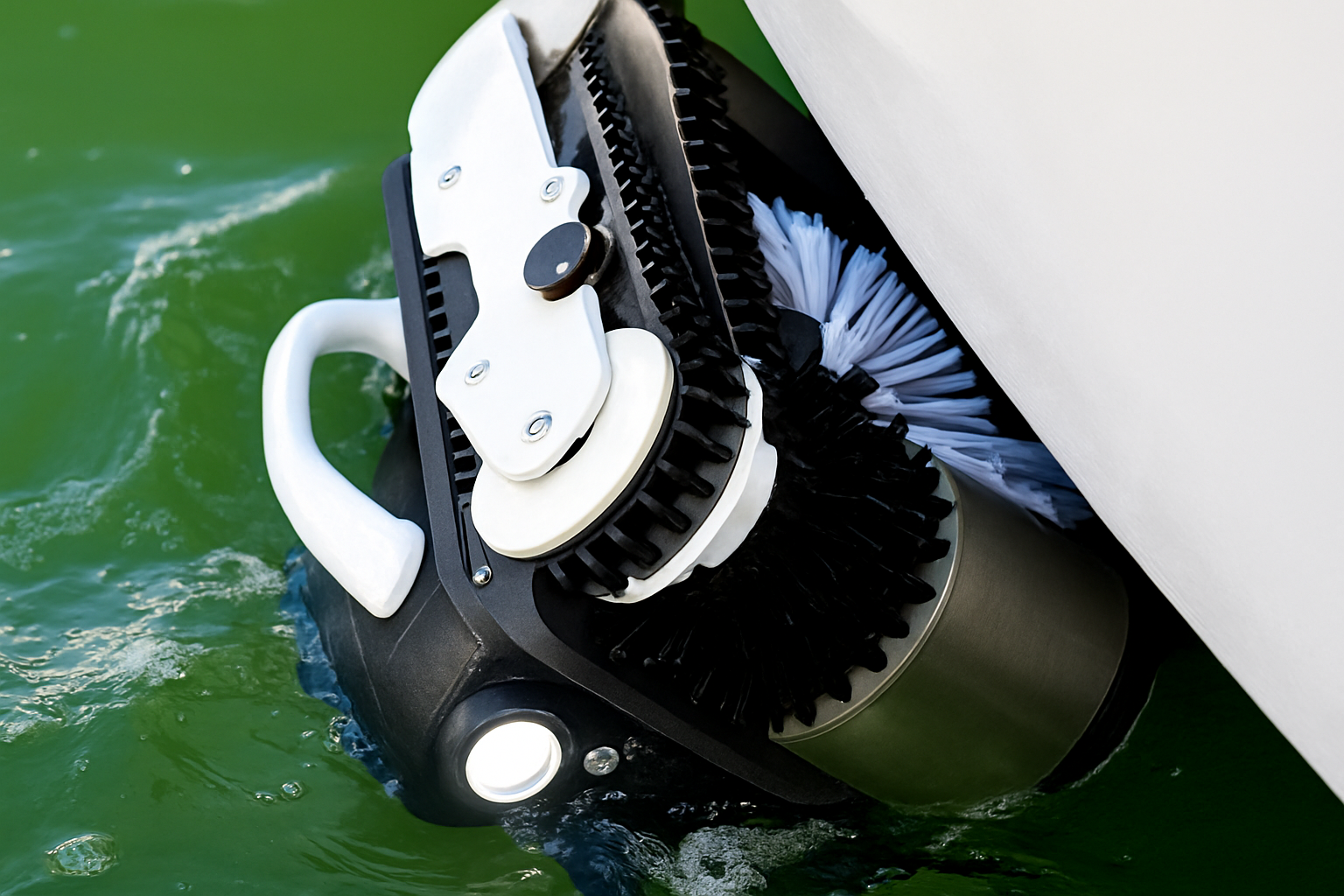The Green Wave in Marine Maintenance
Welcome to Our Latest Update
Ahoy Reader,
At Evolve Robotic Hull Cleaning, we're passionate about revolutionising boat maintenance with innovative, eco-friendly solutions like the Keelcrab underwater drone. As leaders in robotic hull cleaning services, we draw from cutting-edge technology to keep your vessel performing optimally while protecting our oceans. In this in-depth newsletter, we'll explore the profound environmental benefits of Keelcrab hull cleaning, backed by insights from our expertise and authoritative sources across the industry. Whether you're a boat owner, marina operator, or environmental enthusiast, discover how this technology is steering us toward a sustainable future.
What is Keelcrab Hull Cleaning?
Keelcrab is an advanced underwater robotic drone designed for automated hull cleaning, inspection, and maintenance. Manufactured in Italy, it operates as a remotely controlled device that adheres to the hull using specialised mechanisms, such as negative pressure or thrust force adhesion, allowing it to navigate complex surfaces like flat bottoms, vertical sides, and even niche areas. The robot employs rotating disk brushes—available in nylon for gentle cleaning or stainless steel for tougher fouling—combined with a filtration system that captures debris in a nylon bag (with options for 180-micron or finer meshes). This prevents waste from dispersing into the water.
Unlike traditional methods that often require dry-docking or diver intervention, Keelcrab performs in-water cleaning without harsh chemicals or abrasives. It removes algae, barnacles, and early-stage biofouling while preserving antifouling coatings, extending their lifespan. Complementary products like Keelcrab Paint (a biocide-free, transparent antifouling) and ultrasonic systems like UltraCrab enhance its eco-friendly profile by slowing fouling growth naturally.
Key Environmental Benefits of Keelcrab Hull Cleaning
Biofouling—the accumulation of aquatic organisms on ship hulls—poses significant environmental challenges, including increased drag leading to higher fuel use and emissions, as well as the spread of invasive species. Keelcrab addresses these head-on with a proactive, mechanical approach. Here's a breakdown of its benefits:
1. Reduced Fuel Consumption and Lower Greenhouse Gas Emissions
A clean hull minimises hydrodynamic drag, directly improving vessel efficiency. Studies show that even a thin slime layer (0.5 mm thick) covering 50% of a hull can increase emissions by 20-25%. Keelcrab's frequent, gentle cleaning prevents this buildup, leading to fuel savings of up to 20%. For instance, real-world applications have demonstrated reductions in CO2 emissions by hundreds of metric tons per vessel over months of use. This aligns with global decarbonisation goals, as highlighted in IMO reports where biofouling management is linked to lower air pollutants and greenhouse gases.
| Benefit | Impact | Example Savings |
|---|---|---|
| Fuel Efficiency | Up to 20% reduction in consumption | 80-320 metric tons of fuel saved per vessel over 3-7 months |
| Emissions Reduction | Lower GHG output | 256-1,024 metric tons of CO2 avoided per vessel |
| Performance Boost | Increased speed and reduced drag | 2.5-20% improvement in powering requirements |
2. Prevention of Invasive Species Spread
Ships are major vectors for invasive aquatic species, which disrupt ecosystems, harm biodiversity, and affect industries like fisheries and aquaculture. Biofouling transfers these species across oceans, with irreversible ecological and economic consequences. Keelcrab's in-water cleaning captures and contains fouling organisms in its filter bag, preventing their release and spread—unlike traditional diver-based methods that may disperse debris. This complies with IMO's 2023 Biofouling Guidelines, which emphasise minimising transfers through effective hull management. Reports from organisations like GESAMP underscore how such proactive measures protect marine environments from non-indigenous species.
3. Minimised Use of Harmful Antifouling Chemicals
Traditional antifouling paints often contain biocides like copper or zinc, which leach into water and harm marine life. Keelcrab extends the life of these coatings by removing fouling without damaging them, reducing the need for frequent reapplications. Paired with biocide-free options like Keelcrab Paint, it promotes a "green keel" approach, slowing biofouling naturally and aligning with bans on heavy-metal-based paints. Engineering reviews highlight how robotic methods generate neutral waste, avoiding the pollution from dry-dock repainting.
4. Overall Marine Pollution Reduction
By collecting debris in a filter bag, Keelcrab avoids dispersing organic material or microplastics into the water—a common issue with high-pressure jets or manual scrubbing. This supports cleaner waters and complies with emerging regulations, such as those from the EPA and Marine Conservation Society, which note traditional cleaning contributes to 15% of coastal pollution.
Robotic vs. Traditional Hull Cleaning: An Environmental Comparison
Traditional methods like dry-docking or diver scrubbing are labor-intensive, costly, and environmentally taxing. They often involve abrasives that damage coatings, release toxins, and require vessel downtime, increasing overall emissions from idling. Robotic systems like Keelcrab offer:
- Safety and Efficiency: No human divers in hazardous conditions; faster cleaning (e.g., 1500 m²/h in some models).
- Lower Impact: Non-abrasive brushes preserve hull integrity; waste capture reduces biosecurity risks.
- Sustainability Edge: Up to 42% market growth projected for robotic cleaning due to eco-regulations.
Engineering reports emphasise robotics' integration of AI, sensors, and hybrid methods (e.g., brushes with cavitation jets) for non-destructive, efficient cleaning.
References to Key Reports and Studies
- IMO 2023 Biofouling Guidelines: Recommends in-water cleaning to curb invasive species and emissions; supports robotic methods for safe, proactive management.
- GESAMP Report on Marine Biofouling: Details NIS spread via fouling and advocates for low-impact cleaning to safeguard ecosystems.
- Review of Underwater Ship Hull Cleaning Technologies (PMC, 2020): Highlights robotic advantages in neutrality to oceans and reduced coating damage.
- Greensea IQ Whitepaper (2024): Quantifies fuel and emission savings from proactive robotic cleaning.
- Jotun Report on Biofouling (2025): Notes 50% of owners face inefficiencies; robotics offer cost-effective mitigation.
Charting a Sustainable Course Forward
Keelcrab hull cleaning isn't just maintenance—it's a commitment to environmental stewardship. By reducing emissions, curbing invasive, and minimising chemicals, it helps preserve our oceans for future generations. At Evolve Robotic Hull Cleaning, we're proud to offer these services, tailored to your needs. Contact us today to schedule a demo or learn more about integrating Keelcrab into your maintenance routine.
Stay green and sail clean!
Best regards, The Evolve Robotic Hull Cleaning Team www.evolverobotichullcleaning.com



Share:
Marine Horizons: Navigating Towards a Cleaner Future
Below The Scum Line